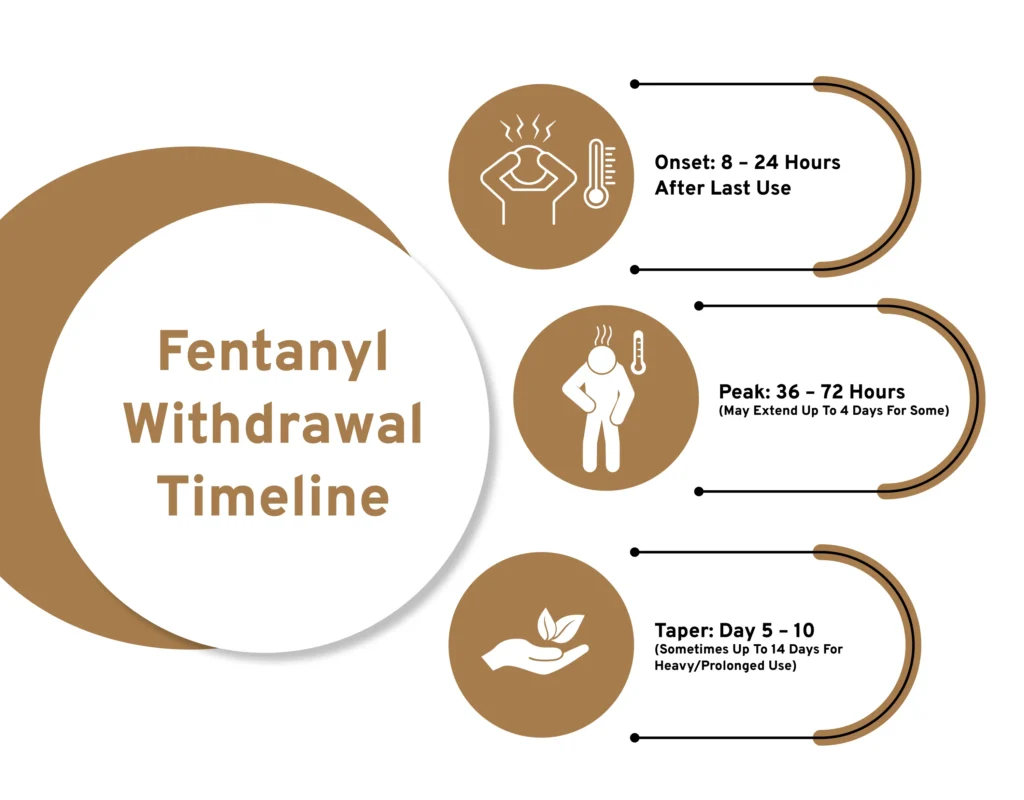Fentanyl is one of the most powerful opioids used today, and while it has an important place in medical care, its illicit use has fueled a worldwide crisis. Because fentanyl is up to 100 times stronger than other opioids, it is extremely addictive and withdrawal can be intense.
For someone who is physically dependent, the idea of stopping fentanyl can be frightening, and many people worry about whether going through a medical detox is really necessary or whether the cost is justified. Understanding what medical detox involves, how much it costs, and what the benefits are can help you make an informed decision about whether it is worth it for you or someone you love.
Why Fentanyl Detox Requires Medical Care
Fentanyl detox is different from detoxing from other opioids because of how potent, fast-acting, and addictive the drug is. When a person who is dependent stops using fentanyl, withdrawal symptoms can start within eight to twenty-four hours.
Withdrawal symptoms can include:
- Extreme muscle pain
- Sweating
- Nausea
- Diarrhea
- Chills Vomiting
- Anxiety
- Uncontrollable Cravings
Because fentanyl stays in fat tissue longer than some other opioids, these symptoms may feel prolonged or unusually intense.
Another important factor is the risk of precipitated withdrawal. This occurs when someone starts buprenorphine, a medication commonly used in detox, too soon after their last dose of fentanyl.
The buprenorphine rapidly removes fentanyl from opioid receptors, triggering a sudden and severe worsening of symptoms.
In a medical detox setting, professionals can avoid this problem by carefully timing medication or using micro-dosing techniques. These small but crucial clinical details are what make medical detox for fentanyl not just safer but more effective than trying to stop on your own.
What to Expect During a Medical Detox
Medical detox is more than simply stopping the drug. It is a structured, supervised process designed to manage withdrawal safely. Upon arrival, a healthcare team will typically complete an assessment, which includes a review of your health history, substance use pattern, and any co-occurring conditions such as depression, anxiety, or other substance use. This information helps create a personalized plan for your detox.
During the program, nurses and doctors monitor your vital signs frequently to watch for signs of complications such as dehydration, elevated blood pressure, or heart rhythm changes.
If your withdrawal symptoms become too difficult to manage, medications can be given to ease discomfort. Methadone or buprenorphine may be used to stabilize opioid receptors, reducing cravings and withdrawal pain.
Non-opioid medications such as lofexidine (Lucemyra) or clonidine can help control anxiety, sweating, and a racing heartbeat. You may also receive IV fluids, nutritional supplements, and medications for nausea or sleep if needed.
Being in a medical setting like a Rehab Center, also provides emotional support. Withdrawal can be mentally challenging, and having trained staff available around the clock makes the process safer and less overwhelming. Medical detox does not just focus on physical stability, it also prepares you to transition into the next phase of recovery.
Understanding the Withdrawal Timeline
The process of withdrawal from fentanyl happens in stages.
The first stage is known as onset. This is when the body begins to react to the absence of the drug, often within the first day after the last use. During onset, you may begin to notice muscle aches, restlessness, and anxiety building.
The next stage is the peak phase. This is when withdrawal symptoms reach their highest intensity. People often experience:
- Severe cravings
- Sweating
- Chills
- Nausea
- Vomiting
- Diarrhea
- Insomnia
This period can be very uncomfortable and is the time when most people relapse if they do not have support.
Finally, symptoms begin to taper. During this stage, which can last up to ten days, the physical pain and nausea subside, but fatigue, depression, and sleep problems may still persist. Having professional support during all three stages can make the difference between successfully completing detox or giving up when it becomes too difficult.

How Much Is a Detox for Fentanyl?
One of the biggest concerns for individuals seeking help is cost. The price of detox varies based on whether the program is inpatient or outpatient, the level of medical care provided, and the length of stay.
Outpatient medical detox typically costs between $1,000 and $5,600. This option allows you to live at home but visit the clinic daily for check-ins and medication. Inpatient medical detox, which provides 24-hour monitoring, can range from $3,000 to $10,000 or more for a five-to-seven-day stay.
Rapid detox or luxury facilities often cost much more, sometimes tens of thousands of dollars, due to the intensive procedures and high-end amenities they offer.
While these numbers may seem high, it is important to consider what you are paying for: round-the-clock care, access to doctors and nurses, medications that make withdrawal safer, and a controlled environment that reduces the risk of relapse.
Many treatment centers accept insurance, Medicaid, or Medicare, which can significantly lower the cost. Others offer payment plans or sliding-scale fees based on income.
When considering how much is a detox for drugs, remember that the investment often prevents emergency room visits, long-term health complications, or continued drug use that can be even more costly.
Why Is Rehab So Expensive?
People are often shocked by the cost of rehab, but there are valid reasons why treatment carries a significant price tag.
A residential or inpatient program is essentially a medical facility operating 24 hours a day. The cost includes doctors, nurses, counselors, meals, medications, security, and the infrastructure needed to keep patients safe and cared for at all times.
In addition, facilities must meet licensing and accreditation requirements, which involve inspections, compliance protocols, and quality assurance, all of which add to operational costs.
Some facilities also provide specialized therapies, private rooms, recreational activities, and holistic services such as yoga or nutrition counseling, which can raise the price even further.
Understanding these factors can make the cost seem less like a random number and more like what it really is a reflection of the comprehensive care being provided.
Why Detox Alone Is Not Enough
Detoxing from fentanyl is only the first step in recovery. Once the drug has left your system, the psychological aspects of addiction remain. Without further treatment, such as counseling, group therapy, or medication-assisted treatment, most people will relapse. A good detox program will help you plan for the next steps, whether that means starting methadone or buprenorphine maintenance, entering a residential program, or continuing with outpatient counseling. This continuation of care significantly lowers the risk of overdose and helps build a foundation for long-term recovery.
Making Fentanyl Detox Affordable
Cost does not have to be the reason you or a loved one avoids treatment. Many programs offer financial assistance, sliding scales based on income, or financing options. If you have insurance, your provider can verify what portion of the detox stay will be covered. Medicaid programs in most states also cover medical detox for opioids. Additionally, non-profit organizations and some government grants can help individuals with little or no income access treatment at low or no cost. Treatment Locator can connect you with affordable programs near you.
Seek professional and supportive help right away!
How much does a medical detox for fentanyl cost?
The cost of a medical detox for fentanyl usually ranges between $3,000 and $10,000 for inpatient programs, depending on the level of care and length of stay. Outpatient programs are more affordable, usually between $1,000 and $5,600. Insurance, Medicaid, or payment plans can help lower these costs significantly, so you don’t have to avoid treatment because of finances.
Can I detox from fentanyl at home?
Detoxing at home can be very dangerous. Fentanyl withdrawal can cause severe nausea, diarrhea, dehydration, and even dangerous blood pressure changes. In a medical detox setting, doctors can monitor your symptoms, give medications to make you more comfortable, and step in if complications arise. Home detox without supervision can also lead to relapse, which increases the risk of overdose.
Is medical detox for fentanyl worth it?
Yes, most people find medical detox worth it because it makes withdrawal safer and more manageable. Trying to quit on your own can be painful and dangerous, leading many to give up before completing detox. Medical detox gives you a safe, supportive environment with 24/7 care, medications to ease symptoms, and a plan for ongoing recovery.
Why is rehab so expensive?
Rehab programs are more than just a place to stay. The cost covers doctors, nurses, therapists, meals, medications, and 24/7 monitoring. Facilities must also meet strict licensing and safety requirements. While it may seem expensive, rehab is an investment in your health and often prevents the even higher costs of ER visits, hospitalizations, and ongoing substance use.
How long does fentanyl withdrawal last?
Most people feel symptoms for 5 to 10 days, but the intensity changes over time. Withdrawal starts (onset) within 8–24 hours, peaks around 36–72 hours, and slowly tapers off. Some mental health symptoms like anxiety or insomnia may last for several weeks. Medical detox can help you get through the worst of it safely.
What medications are used in medical detox for fentanyl?
Doctors often use methadone or buprenorphine to reduce cravings and ease withdrawal pain. Non-opioid medications like lofexidine or clonidine can also help with anxiety, sweating, and racing heart. Nausea medicine, IV fluids, and sleep support are also available. These treatments make withdrawal safer and more tolerable.


